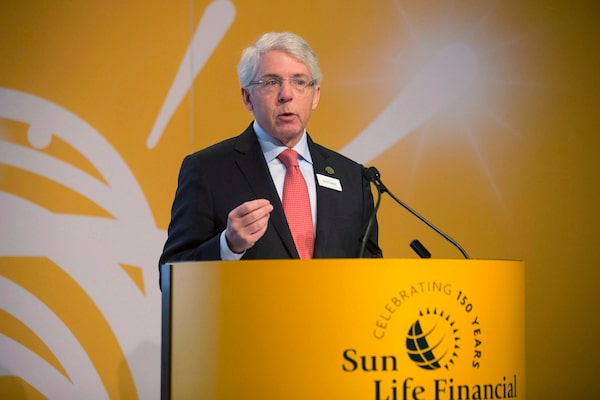
Sun Life Financial Inc. president and CEO Dean Connor speaks at the company's annual general meeting in Toronto in 2015.Chris Young/The Canadian Press
Sun Life Financial Inc.’s CEO Dean Connor is sitting on an influx of spare cash, but it isn’t burning a hole in his pocket.
The chief executive officer came into the spotlight this week as a change in financial reporting within the life insurance industry revealed that Sun Life will soon have $2.9-billion in excess capital at the holding company level.
Industry analysts pressed executives on where Sun Life might spend some of that money on Wednesday, but Mr. Connor indicated that he likes having the flexibility – especially in event that a shoe should drop in the broader financial market.
“It’s a good time in the cycle to have a very strong balance sheet. We’re many years into the bull market. We’re late in the credit cycle,” Mr. Connor said from the company’s new Toronto headquarters after its annual meeting on Wednesday. “I don’t know when those cycles will turn, but I do know that having lots of excess capital and low debt … this is a great time in the cycle to have such a strong balance sheet just from a pure defence position.”
Mr. Connor recalls the height of the financial crisis when spreads on residential mortgage-backed securities spiked to historical highs. “In a moment of crisis when all liquidity was fleeing, if you have liquidity you can really do something special and put money to work for long periods of time,” he said.
The question of what’s next at Sun Life comes after months of more noticeable changes at the other two large Canadian life insurers. Manulife Financial Corp., the country’s largest insurer by market capitalization, has a welcomed a new CEO who’s shuffled management, pledged to sell assets and hived off underperforming legacy businesses. And Great-West Financial Inc. has been working on restructuring and cutting staff in its Canadian business in an effort to reduce costs in an increasingly competitive industry.
Changes to industry requirements for how much capital insurers must hold to ensure the protection of policyholders and creditors swept through the industry at the start of the year. A new measuring stick called the Life Insurance Capital Adequacy Test ( LICAT) replaced the 25-year-old Minimum Continuing Capital Surplus Requirements (MCCSR). The big difference is that LICAT takes a closer look at business risks, on which Sun Life has clamped down significantly in the years since the Great Recession.
Sun Life’s first reported LICAT capital ratio of 139 per cent in its principal life insurance business far exceeded the 130 per cent reported by Great-West and 129 per cent reported by Manulife.
Sun Life also touted its low leverage ratio of just 22 per cent on Wednesday. If the company were to dial that up to its long-term target of 25 per cent, it could represent hundreds of millions more dollars to use to make acquisitions.
“Sun Life’s financial flexibility is second to none in the sector, which will trigger deployment questions,” said Gabriel Dechaine, analyst with National Bank Financial, in a note to clients following the company’s earnings release on Tuesday. He added that although share buybacks and dividends could be used, “we believe Sun Life prefers the M&A option, with a focus on Asia and U.S. group insurance.”
Other insurers seeking to capitalize on Asia’s burgeoning middle class have also been investing heavily in the region and striking partnerships with local banks. But these deals are pricey and extremely competitive. In any case, Mr. Connor wasn’t ready to be more granular on his plans to play defence or offence.
“It’s a nice position to be in – we continue to focus on organic growth. We continue to focus on M&A activity,” Mr. Connor said, noting that Sun Life should be able to bring more to any potential asset or business it buys than just its chequebook.
Sun Life reported first-quarter profit of $669-million on Tuesday after the markets closed, up 21 per cent from the same time a year earlier. The company also said it would increase its dividend by 2 cents per share, or 4 per cent.